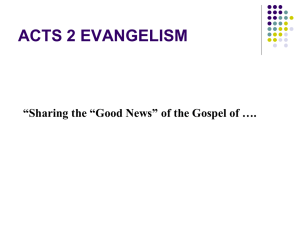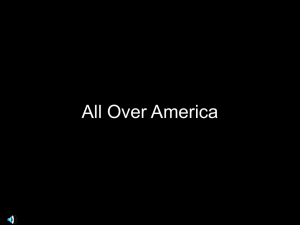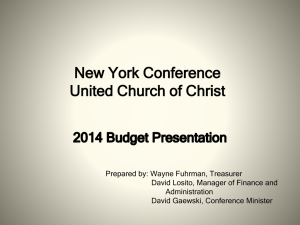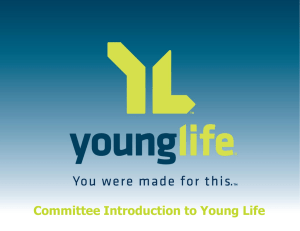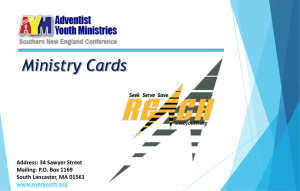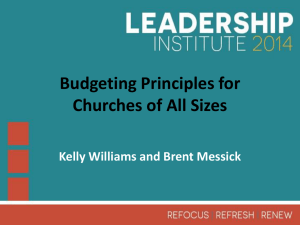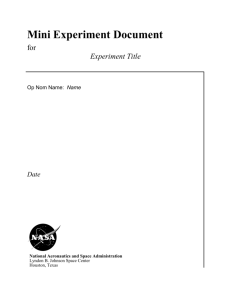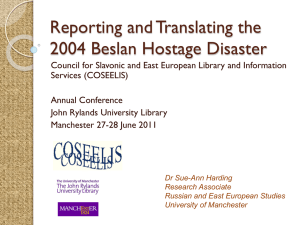Effective Budget Procedures for Churches
advertisement
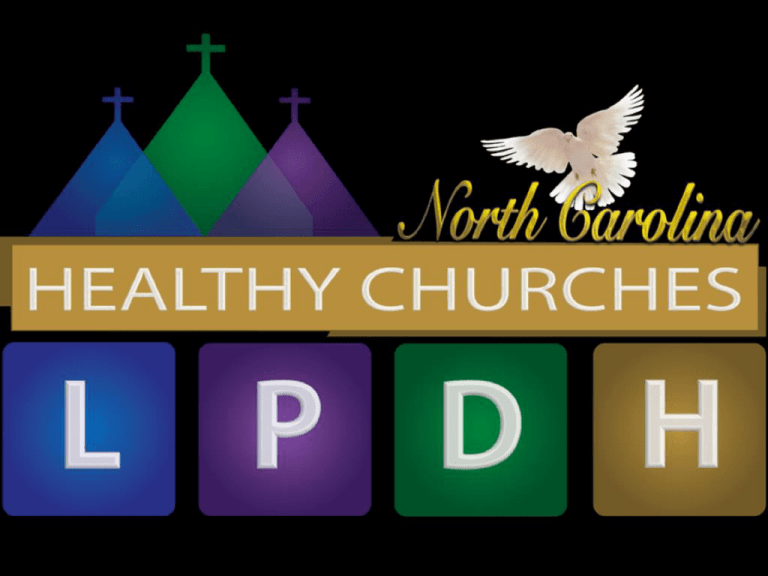
Regional Thrive Tours 2012-2013 The church budget is a “ministry action plan” or a “M.A.P.” that shows the way the church will make its journey this year to fulfill what God has called it to do. It is often expressed in the form of a line item budget and/or a narrative budget. A line item budget objectively serves as a guideline to compare income to expenditures and to pace yourself through the fiscal or financial year. 2013 Annual Budget Monthly Budget Revenue (Income) Tithes, HPL1/L2, TC, HLD, Heritage $111,962 $9,330 $12,000 $1,000 Fundraiser(s) $6,000 $500 Other $3,600 $300 $133,562 $11,130 People (Payroll) Pastor @ limit $56,442 $4,704 Property (Operations) $37,452 $3,120 Programs (Ministries) $39,668 $3,306 Total Expenses $133,562 $11,130 Net (Gain/Loss) $0.00 $0.00 Expense Offerings Total Revenue Expenses Monthly YTD Actual Budget YTD Actual YTD Variance A narrative budget subjectively declares, “This is who we are as the people of God and this is what we do with the resources with which He has blessed us.” Total Budget $133,562 Developing Leaders, $10,552.00 , 8% Harvest, $15,214.00 , 11% Prayer, $5,090.00 , 4% Pastoral Care, $56,442.00 , 42% Love, $8,812.00 , Pastoral Care Ministries Support Love 7% Prayer Ministries Support, $37,452.00 , 28% Harvest Developing Leaders Enables responsible stewardship of resources. Creates openness to a growing vision. Allows for responsive funding of ministries. Defines priorities in planning ministry needs. Communicates the need for financial support to the congregation. Increases confidence and trust in church leaders. Provides an effective tool for stewardship education. Eight Steps to creating an effective budget: 1. Form the Budget Development Committee (BDC) from the Finance Committee (FC). 2. Ministries review previous year and preview next year via Budget Request Forms. 3. BDC evaluates Budget Request Forms. 4. BDC prepares line item budget. Eight Steps to creating an effective budget: 5. BDC presents proposed line item budget to Finance Committee (FC). 6. FC prepares narrative budget from line item budget. 7. Present both line item and narrative budgets to church conference for approval or amending. 8. Communicate narrative budget to local church via stewardship campaign. Form the Budget Development Committee (BDC) from the Finance Committee (FC) ◦ The pastor appoints three or four persons to the BDC from the FC. ◦ At a minimum, these should include the pastor, the finance chair, and the treasurer. ◦ The BDC schedules meetings and a timeline for the budget process (usually 3 months before budget to be presented to conference). ◦ CALENDAR YEAR | FISCAL YEAR | REPORTING YEAR Ministry Directors meet with their ministry teams and review previous year and preview next year (using the Budget Request Form) o o o o o o What are the primary needs of our congregation that are met thru our ministry? What did we do effectively? How can we improve our ministry? Do we need to phase out anything? What new endeavors need funding? What is the amount of funding needed to realistically operate our ministry next year? BDC evaluates Budget Request Forms submitted by ministry directors. o o o o Review funding requests from each ministry. Do these requests contribute to the fulfillment of the church mission and vision? Do these requests support our four core values? Interview Ministry Director(s) as needed for clarification. BDC prepares line item budget. o o o Consider church’s vision, mission, and values. The treasurer should prepare two Income & Expense Reports: one should categorize the previous year, subdivided by months; the other should report the annual Income & Expense totals for the last five years. Note any trends, new vision, or developments over the last few years that may impact your budget (i.e., depressed local economy; loss of members; increased expenses; expected major repairs; hiring a youth pastor; etc.). BDC prepares line item budget. o o o Identify and list all revenue streams by category (i.e., tithes, offerings, fundraisers, church business income, other). Adjust as needed for observed trends or developments. Total all reliable revenue over past year and divide by 12 = average projected monthly operating income available to be budgeted. BDC prepares line item budget. o o o Identify all of the expenditures (by category) for the past year. Usually, there are three major categories: people (payroll), property (operating expenses), and programs (ministries). Adjust as needed for observed trends, new vision, or developments. Total all disbursements for past year and divide by 12 = average projected monthly expenses. BDC prepares line item budget: o o People (Payroll) deals with pay packages (i.e., salary and benefits) for staff: lead pastor, youth pastor, custodian, secretary, etc. Most churches use 40%-50% of their budget here. “People” are our chief resource! Property (Operations) deals with administrative costs: mortgage, rent, insurance, utilities, maintenance, repairs, etc. Most churches use 25%-30% of their budget here. BDC prepares line item budget: o Programs (Ministries): 10% to IO, 2% to state Youth Group, Children’s Church, Specialized Ministries, VBS, Choir, Missions/Harvest Partners, Local Outreach, Worship Team, Seminars (i.e., SOPAS), Sunday School, Youth Camp tuitions, etc. Most churches use 25%30% of their budget here. BDC presents proposed line item budget to FC: o o o o o o FC considers BDC’s proposal. Notes any trends, concerns, new vision, or developments over last few years. Confirms the minimum average amount received and disbursed on a monthly basis and verifies projections from this data. Makes changes or adjustments in all categories, as necessary. Staff and/or Ministry Directors contacted for additional clarification, as needed. Finalizes line item budget to present to conference. 2013 Annual Budget Monthly Budget Revenue (Income) Tithes, HPL1/L2, TC, HLD, Heritage $111,962 $9,330 $12,000 $1,000 Fundraiser(s) $6,000 $500 Other $3,600 $300 $133,562 $11,130 People (Payroll) Pastor @ limit $56,442 $4,704 Property (Operations) $37,452 $3,120 Programs (Ministries) $39,668 $3,306 Total Expenses $133,562 $11,130 Net (Gain/Loss) $0.00 $0.00 Expense Offerings Total Revenue Expenses Monthly YTD Actual Budget YTD Actual YTD Variance FC prepares narrative budget from line item budget: o o o Decide on four to six broad ministry areas for your narrative budget. You could use the core values and add two more. Write one or two descriptive paragraphs for each ministry area. Tell how they are impacting the community, changing peoples’ lives, affecting the missions abroad, etc. Use pictures if possible. Use a pie chart and percentages to visualize how the budget is disbursed. Total Budget $133,562 Developing Leaders, $10,552.00 , 8% Harvest, $15,214.00 , 11% Prayer, $5,090.00 , 4% Pastoral Care, $56,442.00 , 42% Love, $8,812.00 , Pastoral Care Ministries Support Love 7% Prayer Ministries Support, $37,452.00 , 28% Harvest Developing Leaders NO MISCELLANEOUS CATEGORY Love: $10,762 The Greatest Commandments are to love God whole heartedly and to love one another as we love ourselves. We love God through worship Him together as we are led by our Praise Team and Choir who learn and then teach us new songs regularly and who are assisted by our state of the art A/V system. Too, we love one another by supporting and participating in the community food pantry, clothing closet, soup kitchen and benevolence center to assist families in need. Too, our… FC presents both line item and narrative budgets to church conference for approval or amending. Though different in appearance and function, these should complement each other. o The line item budget’s focus is an objective, o neutral, and coldly sterile representation of the figures with an emphasis on numerical accuracy. It is often difficult to comprehend. In contrast, the narrative budget’s focus is a subjective, biased, and warmly passionate information of the ministry areas of the church with an emphasis on how the financial support will be directed to make these ministries work. It is quickly and easily understood. LEGAL IMPLICATIONS OF AN APPROVED BUDGET FC communicates narrative budget to local church via stewardship campaign o o o Develop a communication channel (i.e., power point presentation, dvd, webinar, brochure, handout, etc.) and inform the church of the “M.A.P.” or “ministry action plan” for the coming financial year. Consider an annual Appreciation Banquet where you express your gratitude to everyone who gave and inspire others to come on board. Be inclusive; not exclusive. Use this banquet to launch your financial stewardship campaign for the new year (i.e., show dvd, provide brochures, feature the six main areas of ministry, etc.). FC communicates narrative budget to local church via stewardship campaign o o Schedule messages over the next four to six Sundays on stewardship and focus on one area of ministry each week (include bulletin inserts, use dvd presentations, use testimonials, etc.). Every two to three months (i.e., at quarterly conference), give new emphasis to these areas. Provide updates on how the positive results of these areas. Inform congregation of challenges being faced, etc. Additional resources (info & examples): ◦ See Building a Narrative Budget at http://www.centerforfaithandgiving.org/Resources/ AdministrativeResources/BuildingaNarrativeBudget/ tabid/950/Default.aspx ◦ http://cornerstonefund.org/learn/church-finance ◦ See Treasurer’s Guide, then Budget Procedures, http://cogop.org/ministries/stewardship/freeresou rces.html

